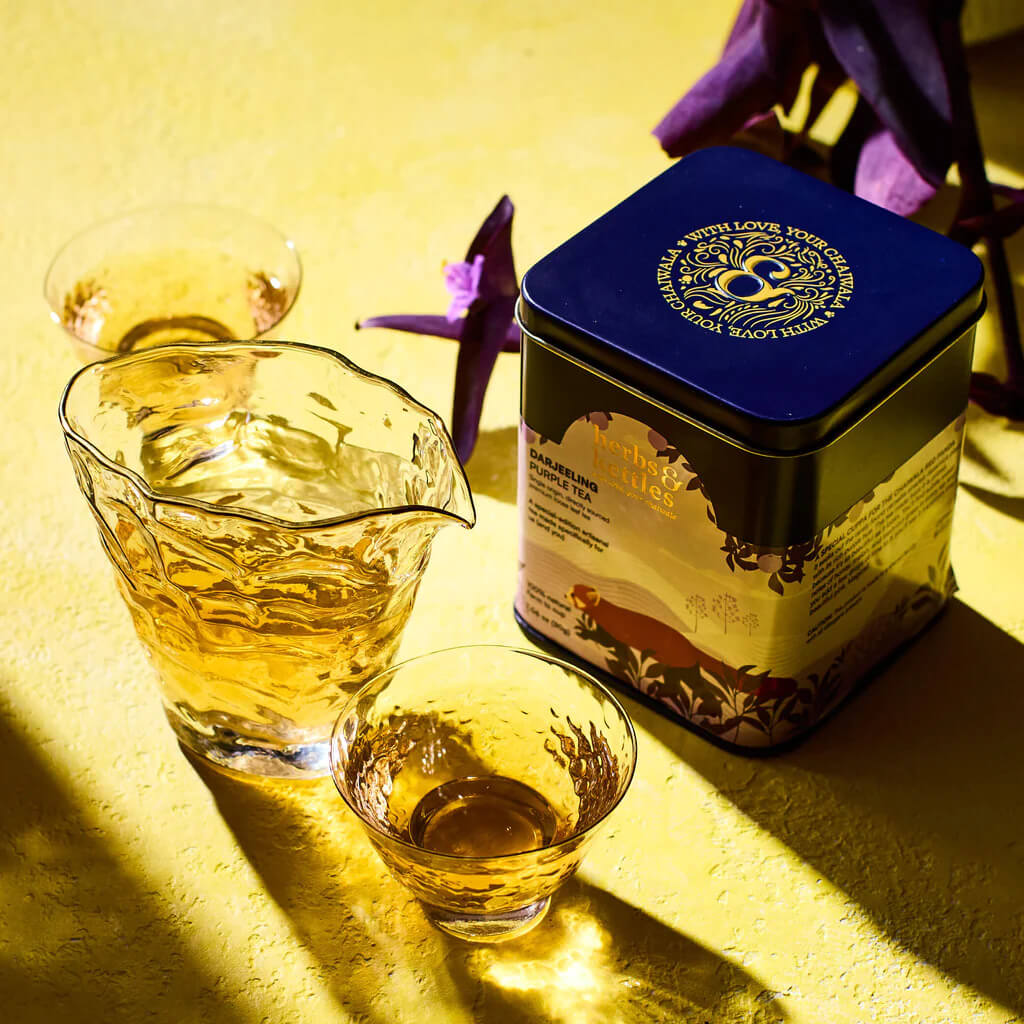No Products in the Cart

Purple tea comes from the Camellia sinensis Assamica variety, which undergoes a natural mutation that leads to increased levels of anthocyanin pigment. Anthocyanin is responsible for the red, blue, and purple color in flowers, vegetables, and fruits like blueberries. Like tea polyphenols, anthocyanins belong to the flavonoid group of compounds and are rich in antioxidants.
Purple tea is not a type of tea, it is just a natural mutation in certain Camellia sinensis var Assamica bushes. Purple tea leaves can be processed to make white, green, oolong, black, and pu-erh teas. Purple tea bushes grew in the wild in North East India and South Western China - the Yunnan province.
In India, purple tea leaf bushes were initially discovered in Assam, possibly in a region called Namrup, and were found growing in the wild. In 1903, a British settler named G.W.L. Caine took purple tea plants from Assam and planted a few in Limuru, Kenya. Kenya has now emerged as a prominent producer of purple tea. Kenyan purple tea, known for its vibrant color and distinct flavor profile, has become accessible globally. While purple tea production thrives in Kenya, India has recently begun producing small artisanal batches.
Our High Mountain Darjeeling Purple Tea is a limited micro-ghani batch crafted especially for us by a small farmer in Darjeeling and available exclusively at Herbs & Kettles.
The exact reasons why some Assamica tea bushes develop a purple hue are not fully understood, and it's likely influenced by a combination of genetic and environmental factors. The germplasm of the North-Eastern part of India and the South-Western part of China is conducive to natural mutations. Here are some factors that may contribute to the development of the purple color in tea leaves:
Genetic Variation: Certain tea cultivars for the Camellia sinensis Assamica variety may have a genetic predisposition to produce higher levels of anthocyanins. This genetic variation can lead to the development of purple leaves.
Environmental Conditions: Factors such as temperature, sunlight exposure, and soil composition can influence the production of anthocyanins. Stressful environmental conditions, including exposure to ultraviolet (UV) light, can stimulate the production of these pigments as a protective response. pH Levels of soils could also influence the development of anthocyanins, and the purple color in tea leaves may become more pronounced under certain pH conditions.
Beyond its distinctive color, purple tea leaf benefits are many, which also supports winter wellness. Let's discuss what purple tea is good for:
Antioxidant Properties:
The purple hue of the leaves indicates a high concentration of anthocyanin antioxidants. These compounds neutralize free radicals, providing cellular protection against oxidative stress. Purple tea's antioxidant-rich profile makes it an excellent choice for supporting overall health during the winter, contributing to immunity and stress relief.
Cardiovascular Benefits:
Catechin antioxidants in purple tea positively influence cardiovascular health, supporting healthy blood circulation and potentially mitigating heart-related risks.
Reduced Stress:
Purple tea contains L-theanine, an amino acid known for its relaxing properties, contributing to stress reduction. Incorporating purple tea into daily routines can establish a calming ritual.
Improved Memory Retention:
Antioxidants in purple tea may have neuroprotective effects, potentially enhancing memory retention and cognitive function.
Weight Management:
For those focused on weight management, purple tea, with its antioxidant content and potential metabolism-boosting properties, can complement winter weight loss plans. It is unsweetened, has zero calories, and is hydrating, perfect for a low-carb diet or intermittent fasting. Thus, choose purple tea for weight loss goals!
Buy Exclusive Purple Tea Online on Herbs & Kettles
Purple tea's caffeine content depends on its processing style and whether it is made into a white, green, oolong, black, or pu-erh tea. It does have caffeine, although possibly lower levels, and if you are sensitive to caffeine or have a hard time going to sleep or falling asleep, I would recommend not drinking caffeinated beverages past noon as the half-life of caffeine ranges between 1-10 hours with average being 3-5 hours.
Steeping and making purple tea is a straightforward process.
You can steep multiple infusions until the tea loses its flavor. Alternatively, for the gongfu method, employ 1gm of tea per 10-20 ml of water, steep for 5-10 seconds, gradually increasing steeping times for subsequent infusions. Both tea steeping methods ensure the enjoyment of the unique characteristics of purple whole leaf tea.
Related read: What do you need to steep tea?
From its origins in Yunnan and India to its thriving production in Kenya, purple tea has carved a niche in the tea world, and its allure continues to grow. Beyond its captivating color, purple tea benefits, making it an ideal companion for health and wellness. Whether you seek an antioxidant-rich tea or a cozy ritual, purple tea stands ready to enhance your experience.